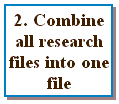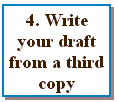Kiosk
If you can dream it,
you can do it Walt Disney 1901 - 66
American cartoonist/entrepreneur |
Reading and research series
Organizing research with computers
& avoiding plagiarism
Plagiarism:
- To use and pass off (the ideas or writings of another) as one's own.
- To appropriate for use as one's own passages or ideas from (another). 1
Plagiaries: accidental using and passing off someone's work or ideas as your own
This Guide is intended to help you avoid accidental plagiarizing
Why document your work with that of others?
Why
reference, footnote, endnote?
- Your research will be better
as you document the quality of your sources - Your argument will be better
with the support of authorities and statistics you quote, paraphrase, and summarize - Your writing style will be better
if your readers can see how you build on, and agree or disagree with the work of others - Sometimes the source says it better
and you may as well use it and cite it - Your readers may be interested in exactly
what your reference says, or in its context, etc. - Citing sources may demonstrate that there are opposing
points of view,
even opposing statistics! or establish consistency for the sake of argument
When is it appropriate to reference another's
work?
When you are
- Quoting directly
- Using unique expressions or ideas of another,
whether from printed resources, the Internet, interviews, even casual conversations - Documenting facts, reproducing images, tables, etc.
- Referencing opinions of experts,
whether or not you agree with them - Getting extraordinary help from someone,
a tutor, a teacher, even a roommate or parent. Why not?
When don't you reference:
When
- A fact or idea is commonly understood
- A reasonable search has led to no author or source
(for example the phrase "give credit where credit is due" seems to be a common expression without an author - What you say is commonly accepted and not cited elsewhere
 When
researching,
When
researching,
how can I organize
and keep track of my
sources?
How can I use my computer effectively?

When beginning a project, create a new folder
Save all your research in separate files in this
folder
Include bibliographic information: author; type of source; web
address, publisher, etc.; date
Develop a "code" that will help you
identify the type of source, the person responsible, and the date
 Combine
all research into
one file
Combine
all research into
one file
- Save it as your research file in this folder, and keep it separate
- Within this combined file, head each section of notes
with the code you developed above - Do not alter this combined research file except to add new research/information
 Duplicate
your combined research file into a working duplicate
Duplicate
your combined research file into a working duplicate
Use "save as" to
create a second file of the research file
Use this file to organize your research
- Use the copy and paste strategy to combine and organize the text, graphics and images
- Create and bold face topics and sub-headings
- Bold face and/or underline common terms, key words, duplicate expressions, arguments for and against
- Delete all that is not useful
- Save and store this second research file in the project folder
- In a separate document, develop an outline or concept map of your paper
 Create
(save as...)
Create
(save as...)
a third file from the re-organized research file
- Add a couple blank pages at the beginning of this file.
- Begin to write your draft.
- Write from your outline/map and from what you remember of your research and preparation
- Only look up the research when necessary in order to keep your focus on the writing.
- Only copy and paste from your research when you quote directly
- Indent quotations to separate them clearly within your draft
- If you need to paraphrase or summarize, make it clear in the text
(According to Joe Landsberger, ...) - After you complete this draft, save it in the project folder.

Create a fourth file from this third
- Delete all the research at its bottom
(Remember: you have not deleted anything in the second and third copies) - Revise this draft into your final paper
- Cite any work of others from your research in footnotes and/or endnotes in the style required
- Print this draft and review for any text or information you may have
reproduced from the first file of your research
 Website overview:
Kiosk guides for learning are a freely accessible educational environment that offers strategies to recognize and realize learning objectives. We accept individual differences without regard to ability and creed; sexual and affectional orientation; caste, tribal and national affiliation; individual, familial and collective history. Our suggestions should be thoughtfully considered for appropriateness and guidance to your situation, relying on elders, mentors, cohorts and/or professionals to achieve learning objectives and outcomes.
Website overview:
Kiosk guides for learning are a freely accessible educational environment that offers strategies to recognize and realize learning objectives. We accept individual differences without regard to ability and creed; sexual and affectional orientation; caste, tribal and national affiliation; individual, familial and collective history. Our suggestions should be thoughtfully considered for appropriateness and guidance to your situation, relying on elders, mentors, cohorts and/or professionals to achieve learning objectives and outcomes.